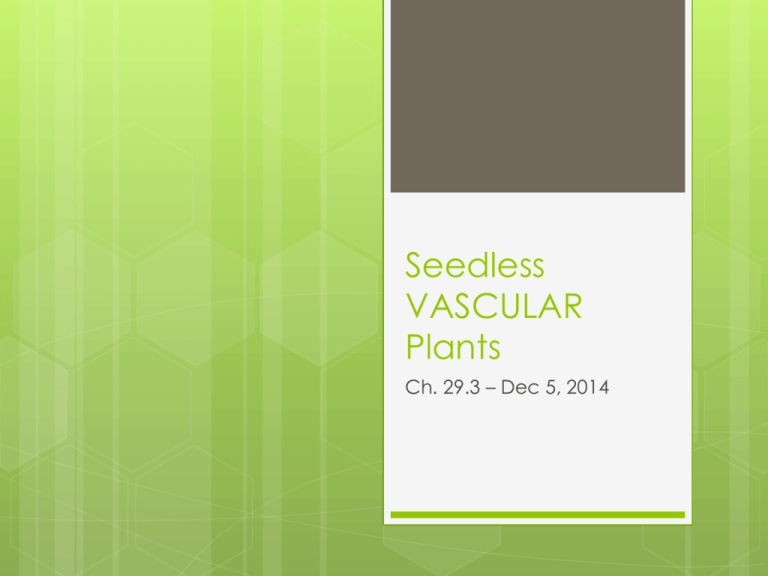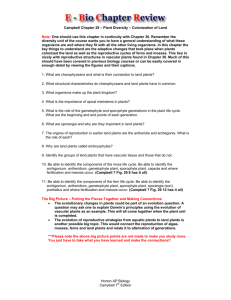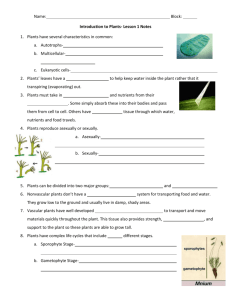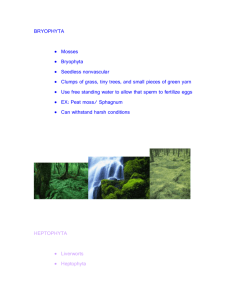Seedless VACULAR Plants - Westgate Mennonite Collegiate
advertisement

Seedless VASCULAR Plants Ch. 29.3 – Dec 5, 2014 Vascular Plants Vascular plants have true… Vascular plants have roots Anchors the plants Absorbs water and nutrients from the soil Vascular plants have stems roots, stems and leaves Conducts water to the leaves Vascular plants have leaves Increase the surface area - more solar energy for photosynthesis Covered by waxy cuticle Regulated pores called stomata Vascular Plants Vascular plants have two types of vascular tissue Xylem Conducts water and minerals Includes dead cells called tracheids Strong walled cells support body of plant Phloem Distributes sugars, amino acids, and organic products throughout the plant Consists of living cells Vascular Plants Sporophyte is the dominant generation in vascular plants Advantageous? Sporophyte is the generation with vascular tissue Sporophyte is diploid Two types of vascular plants: seedless and seeded Seedless Vascular Plants Seedless vascular plants form two phyla: Lycophyta Ex. club mosses Ex. ferns, horsetails, and whisk ferns Pterophyta Both disperse their offspring by producing wind-blown spores When spores germinate, they produce a small gametophyte that is independent of the sporophyte for its nutrition Antheridia release flagellated sperm which swim in a film of external water to the archegonia, where fertilization occurs Seedless Vascular Plants LYCOPHYTES (PHYLUM LYCOPHYTA) Strobili (clusters of sporophylls) Isoetes gunnii, a quillwort Selaginella apoda, a spike moss Diphasiastrum tristachyum, a club moss PTEROPHYTES (PHYLUM PTEROPHYTA) Psilotum nudum, a whisk fern Equisetum arvense, field horsetail Athyrium filix-femina, lady fern Vegetative stem Strobilus on fertile stem WHISK FERNS AND RELATIVES HORSETAILS FERNS Lycophytes Also known as club mosses Among the first land plants to have vascular tissue What group do mosses belong to? Sporangia are born on terminal clusters of leaves, called strobili, which are club shaped Spores can be harvested + sold as lycopodium powder, or vegetable sulfur - used in pharmaceuticals and fireworks Lycophytes Structure Fleshy underground and horizontal stem – rhizome Sends up upright aerial stems Tightly packed, scale like leaves cover the stems and braches Small leaves – microphylls each have a single vein composed of xylem and phloem Ferns Phylum Polypodiophyta Seedless vascular plants Largest group of plants other than flowering plants Great diversity in form and habitat Fronds (leaves) can vary Ferns - Lifecycle Dominant sporophyte produces windblown spores Spores germinate - tiny green and independent gametophyte develops Gametophyte is water dependent Flagellated sperm produced within antheridia require outside sources of moisture to swim to the eggs in archegonia Upon fertilization, zygote develops into the sporophyte Ferns – Adaptations + Uses Leaves of the sporophyte first appear as a fiddlehead, unrolls as it grows Ferns can spread to drier areas with their rhizomes and produce fiddleheads (asexual) Uses Decorative bouquets and ornamental plants Building materials – resist decay Some are eaten…but some are also carcinogenic Complete “Check Your Progress” pg. 609 #1-3 Handouts Whisk ferns and Horsetails Fern diagram Questions Review Dominant Why? Fern generation in vascular plants? versus Moss life cycle Differences? Similarities? What are the three aspects of vascular plants?






